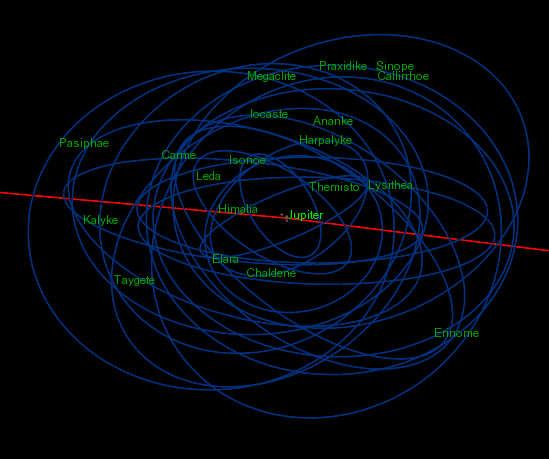Astronomical anniversaries in the month of July
Fascinating anniversaries selected by Elizabeth Cocking.
6th July 1938
Lysithea, a moon of Jupiter, is discovered by Seth Barnes Nicholson with the 100-inch Hooker telescope at Mount Wilson Observatory, California. GIF below : Courtesy ESO

Lysithea takes about 259 Earth days to complete one orbit. Because of its small size, it has a diameter of only 36 kilometres, it does not have enough gravity to form itself into a sphere and is probably irregular in shape. It is thought to have originated as an asteroid that was captured by Jupiter’s gravity and broke apart. Even though it was discovered in 1938 it did not receive its present name until 1975, before then it was known as Jupiter X or sometimes Demeter. It is named from Greek mythology for the mythological Lysithea daughter of Oceanus.
14th July 1965
NASA spacecraft Mariner 4 flies past Mars and captures the first images ever of another planet. Its closest approach was 9,846 km from the Martian surface. Over a few hours Mariner 4 took a total of 21 pictures of Mars, each photo covering an area of about 200 square kilometres, just 1% of the Martian surface.

The total data returned was 5.2 million bits stored in the onboard tape recorder, cutting edge technology for its time. After its flyby the spacecraft coasted into solar orbit continuing to return data to Earth for another three years. Final contact with the spacecraft was lost on the 21st December 1967.
Image Left: Mariner 4's first image, courtesy NASA
31st July 1971
Apollo 15 astronauts Dave Scott and Jim Irwin become the first humans to drive on the Moon when they operate the Lunar Roving Vehicle (LRV) in three separate trips across the lunar surface covering 28 kilometres.

The LRV was a lightweight electric vehicle designed to operate in the low-gravity vacuum of the Moon. It was capable of traversing the lunar surface at a top speed of 9.7 kilometres per hour and allowed Apollo astronauts to extend the range of their extravehicular activities.
When they finished Scott and Irwin parked the LRV a short distance from the lunar module, where it still sits today - the first of three rovers left on the moon by future Apollo missions.
Image left: Jim Irwin operates the LRV. NASA
BORN
11th July 1918 Venetia Burney.

As an 11 year old girl she had the distinction of being the only female to have named a planet. In 1930 just months after the planet Pluto was discovered she suggested the name Pluto. Her grandfather mentioned this to his friend Herbert Hall Turner, professor of astronomy at Oxford University, who in turn forwarded it to the Lowell Observatory in Arizona where astronomers, including Clyde Tombaugh, who had made the discovery were delighted with her suggestion. Pluto was one of the few names in classical mythology not yet in use, and the first two letters were the initials of observatory founder Percival Lowell, who predicted the existence of a new body in the outer solar system.
Before her death in 2009 Venetia refuted a rumour that she had named the planet after Walt Disney’s cartoon dog. The dog was named after the planet, rather than the other way round. The asteroid 6235 Burney and the Burney Crater on Pluto are named in her honour. In July 2015 the New Horizons spacecraft was the first to visit Pluto and carried an instrument named the Venetia Burney Student Dust Counter in her honour.
1st July 1921 Gordon J. Stanley.

New Zealand-born radio astronomer. He joined the CSIRO Division of Radiophysics in 1944 where he became an expert in the design and construction of antennas and receivers. He worked with John Bolton at the Dover Heights Field Station in Sydney on the detection of radio emissions from Cygnus and other stars.
In 1947 they discovered the first radio star Cygnus A. In 1955 Stanley followed Bolton to the California Institute of Technology. He later helped establish and was Director of the Owens Valley Radio Observatory from 1961 to 1975. Late in his career Stanley adapted interferometers for such projects as measuring sea-ice temperature for the University of Washington and measuring the upper atmospheric temperature for the Japanese government. Image above: Gordon Stanley at the Owens Valley Radio Observatory (courtesy: Robert Cowan).
More information: https://www.publish.csiro.au/as/pdf/as04008
19th July 1947 Sir Brian Harold May CBE.
English astrophysicist and guitarist with the rock group Queen. Prior to his time in the band he studied for a PhD degree at Imperial College, studying “reflected light from interplanetary dust and the velocity of dust in the plane of the solar system”. When Queen began to have international success in 1974, he abandoned his studies. In October 2006 May re-registered for his doctorate at Imperial College and submitted his thesis in August 2007. In recent years he has had a distinguished career in the astronomy and space community. From 2008 to 2013 he was Chancellor of Liverpool John Moores University and in 2015 during NASA’s New Horizons mission to Pluto he worked as a science team collaborator. He is also on the advisory board of the NEO-MAPP project (Near-Earth-Object Modelling and Payloads for Protection). In September 2022 he was awarded the Stephen Hawking Medal for Science Communication. In December 2022 May was made a Knight Bachelor in the 2023 New Year Honours for services to music and charity, the first list of honours in King Charles III's reign. In March 2023, May was officially knighted by the King.

Image above: ESO/G. Huedepohl - http://www.eso.org/public/images/ann15074a/
On 28 and 29 September 2015, ESO’s Paranal Observatory welcomed a very special visitor — British rock guitarist, singer, songwriter and astrophysicist, Brian May. Famed for being the lead guitarist of the legendary rock band Queen — May also has a passion for astronomy. This picture shows Brian May in one of the domes of the ESO Very Large Telescope.

